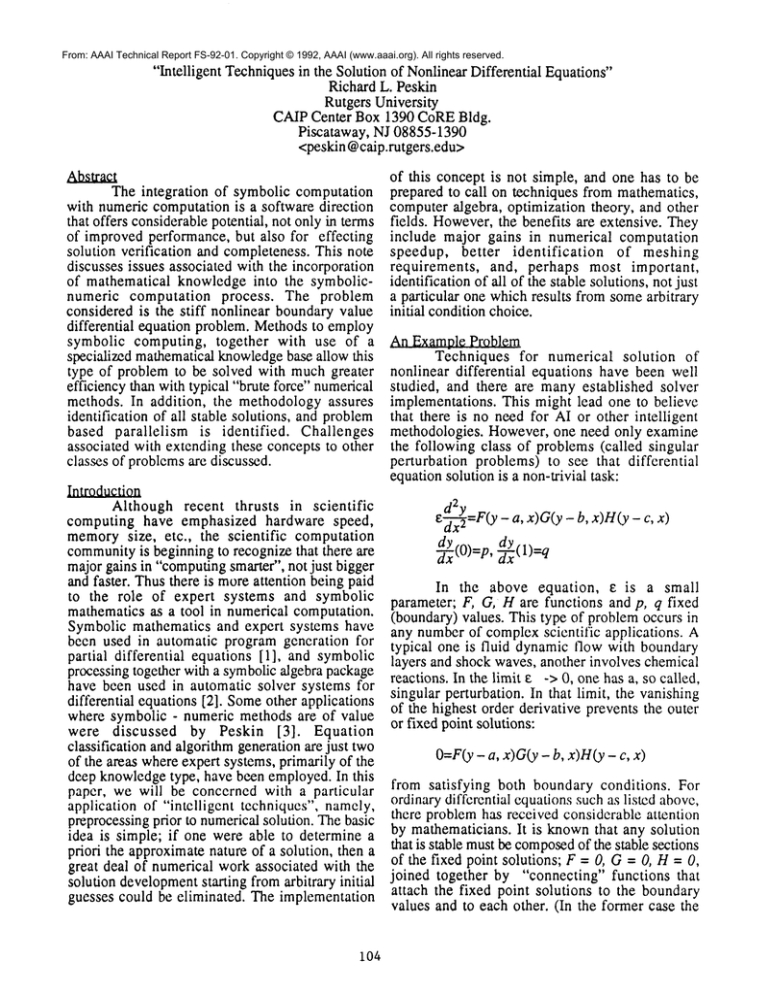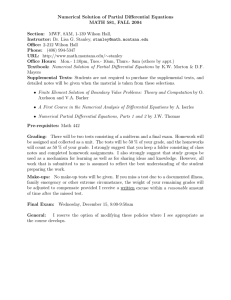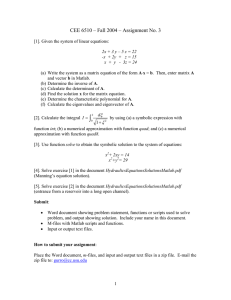
From: AAAI Technical Report FS-92-01. Copyright © 1992, AAAI (www.aaai.org). All rights reserved.
"Intelligent Techniquesin the Solution of Nonlinear Differential Equations"
Richard L. Peskin
Rutgers University
CAIP Center Box 1390 CoREBldg.
Piscataway, NJ 08855-1390
<peskin@caip.rutgers.edu>
Abstract
The integration of symbolic computation
with numeric computation is a software direction
that offers considerablepotential, not only in terms
of improved performance, but also for effecting
solution verification and completeness. This note
discusses issues associated with the incorporation
of mathematical knowledge into the symbolicnumeric computation process. The problem
considered is the stiff nonlinear boundary value
differential equation problem. Methodsto employ
symbolic computing, together with use of a
specialized mathematicalknowledgebase allow this
type of problem to be solved with muchgreater
efficiency than with typical "brute force" numerical
methods. In addition, the methodology assures
identification of all stable solutions, and problem
based parallelism is identified.
Challenges
associated with extending these concepts to other
classes of problemsare discussed.
Introduction
Although recent thrusts in scientific
computing have emphasized hardware speed,
memorysize, etc., the scientific computation
communityis beginning to recognize that there are
major gains in "computingsmarter", not just bigger
and faster. Thusthere is moreattention being paid
to the role of expert systems and symbolic
mathematics as a tool in numerical computation.
Symbolic mathematics and expert systems have
been used in automatic program generation for
partial differential equations [1], and symbolic
processing together with a symbolicalgebra package
have been used in automatic solver systems for
differential equations [2]. Someother applications
where symbolic - numeric methods are of value
were discussed
by Peskin [3]. Equation
classification and algorithm generation are just two
of the areas whereexpert systems, primarily of the
deep knowledgetype, have been employed. In this
paper, we will be concerned with a particular
application of "intelligent techniques", namely,
preprocessingprior to numericalsolution. Thebasic
idea is simple; if one were able to determine a
priori the approximatenature of a solution, then a
great deal of numerical workassociated with the
solution developmentstarting fromarbitrary initial
guesses could be eliminated. The implementation
104
of this concept is not simple, and one has to be
prepared to call on techniques from mathematics,
computer algebra, optimization theory, and other
fields. However,the benefits are extensive. They
include major gains in numerical computation
speedup, better identification
of meshing
requirements, and, perhaps most important,
identification of all of the stable solutions, not just
a particular one which results from somearbitrary
initial condition choice.
An Example Problem
Techniques for numerical solution of
nonlinear differential equations have been well
studied, and there are manyestablished solver
implementations. This might lead one to believe
that there is no need for AI or other intelligent
methodologies. However, one need only examine
the following class of problems (called singular
perturbation problems) to see that differential
equationsolution is a non-trivial task:
d2y_
~.-~x2-F(y- a, x)G(y - b, x)H
dy
dx (O)=P,~-~(1)=q
c, x)
In the above equation, e is a small
parameter; F, G,H are functions and p, q fixed
(boundary) values. This type of problemoccurs
any numberof complexscientific applications. A
typical one is fluid dynamic flow with boundary
layers and shock waves, another involves chemical
reactions. In the limit e -> 0, one has a, so called,
singular perturbation. In that limit, the vanishing
of the highest order derivative prevents the outer
or fixed point solutions:
0=F(y- a, x)G(y - b, x)H(y - c,
from satisfying both boundary conditions. For
ordinary differential equations such as listed above,
there problemhas received considerable attention
by mathematicians. It is knownthat any solution
that is stable mustbe composed
of the stable sections
of the fixed point solutions; F = 0, G = 0, H = 0,
joined together by "connecting" functions that
attach the fixed point solutions to the boundary
values and to each other. (In the former case the
From:
AAAI Technical
ReportaFS-92-01.
Copyright
AAAI
(www.aaai.org). All rights reserved.
connection
is called
boundary
layer;© 1992,
in the
latter
it is a shock. In certain cases the connectionjoins
derivatives of the fixed point solutions and this is
called a corner layer. Each of these layers has
physical interpretation.)
One interesting feature of this problemis
that there is not necessarily a uniquesolution; any
solution joining the stable regions to each other
and the boundaryvalues is admissible. In the above
example, three solutions are possible. A "brute
force" numerical approachwould, most likely, find
only one solution. Another numerical problem
occurs with the need to identify locations of the
"singular" layers, for these are the regions where
most rapid changes occur and, thus, require the
greatest numerical resolution. While the location
of the boundary layers maybe obvious, locations
of shockor comerlayers is not. It is inefficient to
impose
fine resolution over the whole domainwhen
such resolution is required only over a small portion
of the domain. Additionally, numerical techniques
that are based on initial guesses can be very
consumptive of computing resources just to relax
the initial guess to somethingapproachingthe actual
solution.
Current Research Directions
For the past three years we have been
developing intelligent
(e.g. AI) computation
techniques to address these problems for both
ordinaryand partial nonlineardifferential equations.
[3,4,5] Our approachhas been to incorporate expert
system and path searching technology into
numerical solvers with the objective of: (a)
identifying the stable regions of the fixed point
solutions to be connected, (b) approximating the
functional formof the "connectors", (c) identifying
all possible stable paths joining connectorsand fixed
point solutions, (d) using a,b,c to locate the singular
layers in advance as well as specifying an
appropriate initial approximationfor each possible
solution. Anadditional benefit from the use of AI
techniques is the identification
of levels of
parallelism inherent in the solution process.
The intelligent techniques that we use are
based on the computational instantiation
of
mathematicalresults from the study of the theory
of differential equations. Thefirst challenge is to
developequivalent localized versions of the relevant
mathematicaltheorems; the global forms developed
by mathematiciansare not well suited for computer
implementation.
Once this was done, the
computationaltasks to establish a,b,c,d, abovewere
implemented. (a) requires that each fixed point
solution be satisfy a set of partial differential
inequalities of the form,
105
~2q+lR(u(x)’x) > m > 0
~u2q+l
whereR represents
the right handside of the original
equation (F*G*H),and is a f ixed poi nt sol ution
candidate. These inequality relations (which form
part of our expert system) determine the range of
stable solutions for several classes of stability. (See
the paper by Russo and Peskin [4] for details.) We
have employeda computer algebra system (Maple)
to do this task. As part of this task the algebra
system also solves for the fixed point solutions.
However,this sort of task is greatly stressing the
capabilities of commercially available computer
algebra systems, and other techniques to deal with
these partial inequalities are under investigation.
Oncethe stable regions are found, sufficient
parametersare available to do (b). Themathematical
theoremsprovide boundingfunctional relations that
can be used to determine "connectors"; these
relations are part of the expert system. Again the
computer algebra system can be used for
simplification and evaluation. Givenall the stable
regions and connectordefinitions, the determination
of paths (c) can be effected by "usual" AI path
finding techniques. Fortunately, most practical
problems do not admit so manypossible solutions
that this is an onerous computational task for
ordinary differential equations, however,it maybe
non-trivial for partial differential equations. Finally
(d) is accomplished by collecting each complete
path that joins the boundary values and stable
regions of the fixed point solutions. Assumingthe
computer algebra system is able to provide a
symbolic solution for the fixed points, then each
admissible path is symbolically determined.
(Otherwise we mayhave a mixed symbolic numeric
representation.) Eachpath forms a completeinitial
guess for the succeeding numerical processing. In
addition, the location of singular layers is known,
so that localized grid refinementcan be used.
This procedure (AI based mixed symbolic
numeric solution) provides several benefits. The
initial solutions identified (symbolically) are very
close to "final" solutions. This implies very large
overall speedup for the numerical portion of the
process. Thelocating of singular regions also results
in more efficient
numerical computation. Of
importance is the ability of this methodologyto
identify ALLstable solutions, not just one which
is a result of arbitrary initial condition choice.
Furthermore, the symbolic initial solution can be
used to gaugethe viability of numericresults.
The methodologyresults in identification
of the followinglarge grain parallelization:
becomes
considerable
more sparse as equation
Numerical
solution
forFS-92-01.
each Copyright
admissible
solution
From: AAAI Technical
Report
© 1992,
AAAI (www.aaai.org).
All rights
reserved.
can proceed in parallel, (2) Numericalsolution for complexity increases.
We are currently
any given path can be done in parallel because the experimenting with the application symbolic solutions in the vicinity of the singular regions are numericmethodsto classes of differential equations
essentially independent of each other (since they which exhibit bifurcation behavior. But we are no
where near being able to apply these methods to
are connected through the know fixed point
solutions). (3) Symbolicprocessing to determine complex systems such as the Navier-Stokes
stable regions for each fixed point solution can be equations. Giventhe difficulty of establishing firm
mathematical results for nonlinear systems, such
donein parallel.
that those results could be incorporated into
knowledgebases, one is tempted to look at other
Challenges
There are a numberof challenging problems approaches to access the needed mathematical
to be studied as we advance this mixed symbolic information. Weare currently researching the use
numeric approach. The heavy reliance on computer of graphical based qualitative knowledgeas an
algebra systems has begun to tax their current alternative to traditional quantitative theoretical
capabilities. These systems (Mathematica, Maple, methods.
etc.) were designed to service moregeneral user
needs. While traditionally emphasizingalgebraic Samma=
In summary,use of AI techniques and expert
operations such as GCDdetermination, later
as a preprocessor in differential
versions nowprovide manynumerical services, such system methodology
as differential equation solution. But solution of equation solvers offers muchpromise. Results to
stiff boundaryvalue problemsis difficult, if not date have yielded significant numerical speedup,
impossible using most of the commercialcomputer ability to identify all possible solutions, and ability
algebra packages. Wehave found limitations like to identify parallelization for the solution process,
excessive expansion of terms to be moresevere as and ability to providea viability checkfor numerical
we deal with more complex problems such as results. Numerouschallenges are presented, such
nonlinearpartial differential equations.Of particular as the need to provide computer based symbolic
concern has been the ability of these systems to operations aimed primarily for numeric - symbolic
deal with the simultaneous partial differential
use, as opposedto the moregeneral uses whichare
inequalities required for determinationof stability.
the subject of most available symbolic packages.
Weare currently looking at alternatives
to For immediate needs, better methods of handling
differential inequalities are essential. Future
commercial algebra packages. One possible
approachis the use of optimization algorithms [6]. enhancement of this approach may depend on
While symbolic solution is most desirable, some advances is symbolic computational mathematics
of the newer parallel optimization packages may implemented themselves with expert system and
AI techniques. Weneed to provide sophistication
be able to provide accurate solutions rapidly.
Assuming we continued to use pure symbolic in symboliccomputationthat will be on a par with
methods,clearly there is a needfor parallel symbolic that of numeric computation.
computation methods. While we can identify
concurrent symbolic tasks, at present we can only Acknowledgments
Research sponsored by NSF Grant ECSeffect these as distributed. That is, although our
9110424, and by the Rutgers University CAIP
methodologyidentifies parallel symbolic tasks,
there is a need for parallel symbolicpackagesthat Center.
can take advantageof such identification. There is
a need to "standardize" the mathematical expert References
componentsso that the methodology can be made
moreportable. This particularly true as we expand [1] Kowalski, A.D., Russo, M.F., Peskin, R.L.,
the class of equations handled. One of the most "Anatomy of Agnes: An Automatic Generator of
important challenges comes in expanding this
Numerical Equation Solutions", Mathematics and
overall approach to other classes of equations, Computersin Simulation, 31 (1989), pp. 343-352
including partial differential equations. The [2] Boubez,T.I., Froncioni, A.M.and Peskin, R.L.
methodologyclearly rests on a strong foundation "A Prototyping Environment for Differential
of fundamental mathematical knowledge. The Equations", Proc. of IMACS
2nd Intemational Conf.
success of applying our intelligent techniques on Expert Systems in Numerical Computing,
depends on the existence of the necessary
Intelligent Scientific Software Systems, North
mathematical knowledgebase. This knowledgebase Holland, 1990.
106
From:
TechnicalR.L..
Report FS-92-01.
Copyright
© 1992, AAAI (www.aaai.org).
All rights reserved.
[31 AAAI
Peskin.
"Symbolic
Computation
in
Engineering User Interface Systems". Proc. of the
Symposiumon Symbolic Computations and their
Impact on Mechanics, Noor, A.L., Elishakoff, I.
and Hulbert, G. ed., ASME,pp. 97-111, Nov.
1990.
[4] Russo, M. F. and Peskin, R. L. "Automatically
Identifying the Asymptotic Behavior of Nonlinear
Singularly Perturbed Boundary Value Problems"
J. of AutomatedReasoning, V. 8 N. 3, June 1992
[5] Russo, M. F. and Peskin, R. L. "Automatic
Domain Partitioning
for Parallel
Program
Generation Using Nonlinear Singular Perturbation
Theory" in "Parallel Processing for Scientific
Computing"SIAM,Phila., 1989 pp. 180
[6] Russo, M. F. private communication,July 1992
107





